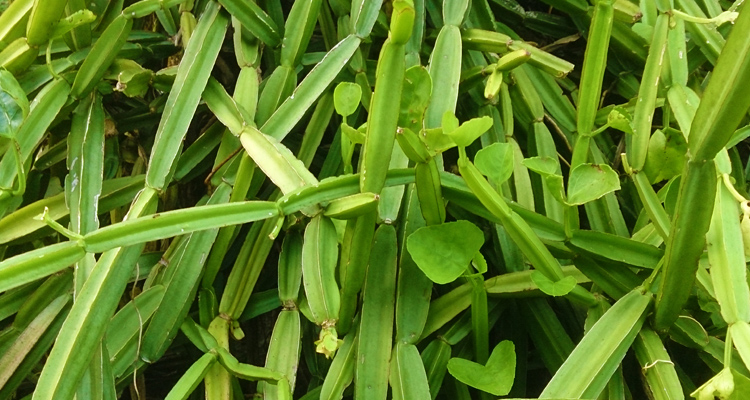 A perennial, succulent vine belonging to the grape family, Cissus quadrangularis has been used in Ayurvedic medicine for centuries to treat a wide variety of illnesses, diseases and especially to promote healing of bone fractures. Native to Asia and Africa, Cissus quandrangularis exerts analgesic, anti-inflammatory and antioxidant properties attributed to potent phytochemicals contained in its leaves, stems and flowers.
A perennial, succulent vine belonging to the grape family, Cissus quadrangularis has been used in Ayurvedic medicine for centuries to treat a wide variety of illnesses, diseases and especially to promote healing of bone fractures. Native to Asia and Africa, Cissus quandrangularis exerts analgesic, anti-inflammatory and antioxidant properties attributed to potent phytochemicals contained in its leaves, stems and flowers.
Mechanisms of Action
Containing steroids and vitamins conducive to healing bone fractures, it seems to promote connective tissue regeneration to facilitate bone remineralization following a break or fracture. 1 Research shows that Cissus quadrangularis may shorten healing of fractures by at least two weeks as phytochemicals stimulate growth of cells important to rebuilding bone, specifically osteoblasts, chondroblasts and fibroblasts. In addition, it also helps improve the chemical composition (phosphorous, calcium, collagen and mucopolysaccharides) important to healing bone fractures. Other beneficial phytochemicals discovered in Cissus quadrangularis include phytosterol substances (for lowering cholesterol), carotene (needed for conversion of vitamin A) and abscorbic acid (vitamin C). 2
Research also indicates that fiber/phytosterol extracts of Cissus quadrangularis have appetite-suppressing and anti-lipase (decreases absorption of fats in the intestines) properties to help lose weight. In addition, it seems to enhance satiation (feelings of fullness) by increasing levels of serotonin in the brain. 3
Research with mice given higher than normal doses of Cissus quadrangularis, the plant showed it may have muscle-relaxing, sedative effects on the central nervous system. 4 In the study, male mice were given doses of Cissus quadrangularis according to body weight and exposed to the seizure-producing effects of isonicotinic hydrazide acid. Tests showed strong analgesic and muscle relaxant activity in the mice. Paw-licking, a sign of hyperactivity in mice, was significantly delayed. Results suggested that it exhibits analgesic, muscle relaxant and anti-convulsant properties that may be useful in treating chronic pain or epileptic conditions.
Conditions Treated with Cissus Quadrangularis
Ayurvedic medicine practitioners use Cissus quadrangularis to treat:
- Diabetes
- Heart disease
- High cholesterol
- Metabolic syndrome risk factors
- Obesity
- Osteoporosis
- Bone fractures
Body builders also take Cissus quadrangularis instead of anabolic steroids as a way to avoid unwanted side effects of steroids. 5
Potential Drawbacks of Taking Cissus Quadrangularis
Since Cissus quadrangularis may lower blood glucose, diabetics taking it along with prescription medication for their diabetes should regularly monitor their blood sugar. Hypoglycemia could occur when Cissus quadrangularis is combined with diabetic drugs. Additionally, it could interfere with normal blood glucose levels surgery. For this reason, people undergoing a planned surgery should stop taking it at least two weeks prior to surgery.
Women who are breast-feeding or pregnant are advised not to take Cissus quadrangularis since there is a lack of clinical information regarding its effects on lactating or pregnant women. 6
How is Cissus Quadrangularis Taken?
In Ayurvedic medicine, all parts of the plant are used to make oral, powdered or topical applications. When sold as a supplement at health stores or online, Cissus quadrangularis is available in capsule and powdered form that can be mixed with water or other beverage. The powdered form is said to be more potent than capsules. Recommended doses of powdered Cissus quadrangularis range between 600 and 1000 mg taken two or three times per day. It may be more effective if it is taken 30 to 45 minutes before eating a meal. Some users may notice results within seven to 10 days while others may not experience benefits until they have taken the supplement for one to three months. Dosage amounts can be increased as time passes according to how well a condition or disease responds.
Sources
- Clinical evaluation of cissus quadrangularis and moringa oleifera and osteoseal as osteogenic agents in mandibular fracture ↩
- Joslin Diabetes Center ↩
- The use of a Cissus quadrangularis formulation in the management of weight loss and metabolic syndrome ↩
- CNS activity of aqueous extract of root of Cissus quadrangularis Linn. (Vitaceae) ↩
- CISSUS QUADRANGULARIS – WebMD ↩
- CISSUS QUADRANGULARIS – WebMD ↩
